University Name: SEN 2120 - User Centered Design and Usability Report
VerifiedAdded on 2022/10/17
|8
|1892
|17
Report
AI Summary
This literature review delves into the critical role of usability in user-centered system design, emphasizing principles crucial for software developers and designers throughout the project lifecycle. It highlights the importance of incorporating empirical evidence, focusing on design elements and usability evaluation methods. The review elaborates on key principles such as user focus, active user involvement, evolutionary system development, simple design representation, prototyping, explicit design activities, and holistic design. It also details the tools applied in user-centric system design, including activity lists and compliance mechanisms. The report further explores the practical applications of user-centered design, encompassing explanation models, process development, knowledge transfer, procurement support, and client-contractor relations. The conclusion underscores the significance of a user-centric approach for enhancing system usability and meeting project expectations, along with the challenges in defining and implementing these principles effectively. The report is a comprehensive guide to understanding and applying user-centered design and usability engineering principles.
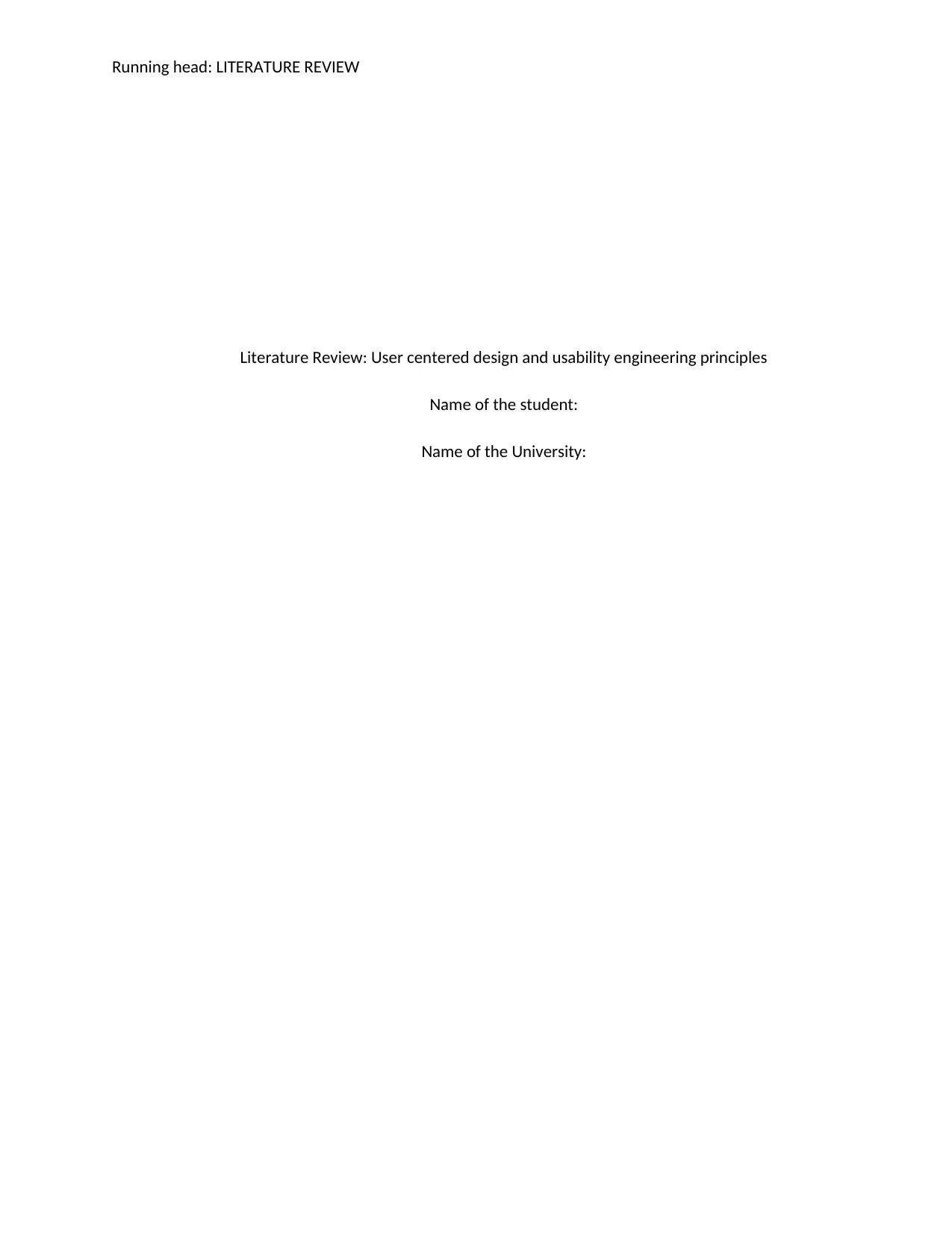
Running head: LITERATURE REVIEW
Literature Review: User centered design and usability engineering principles
Name of the student:
Name of the University:
Literature Review: User centered design and usability engineering principles
Name of the student:
Name of the University:
Paraphrase This Document
Need a fresh take? Get an instant paraphrase of this document with our AI Paraphraser
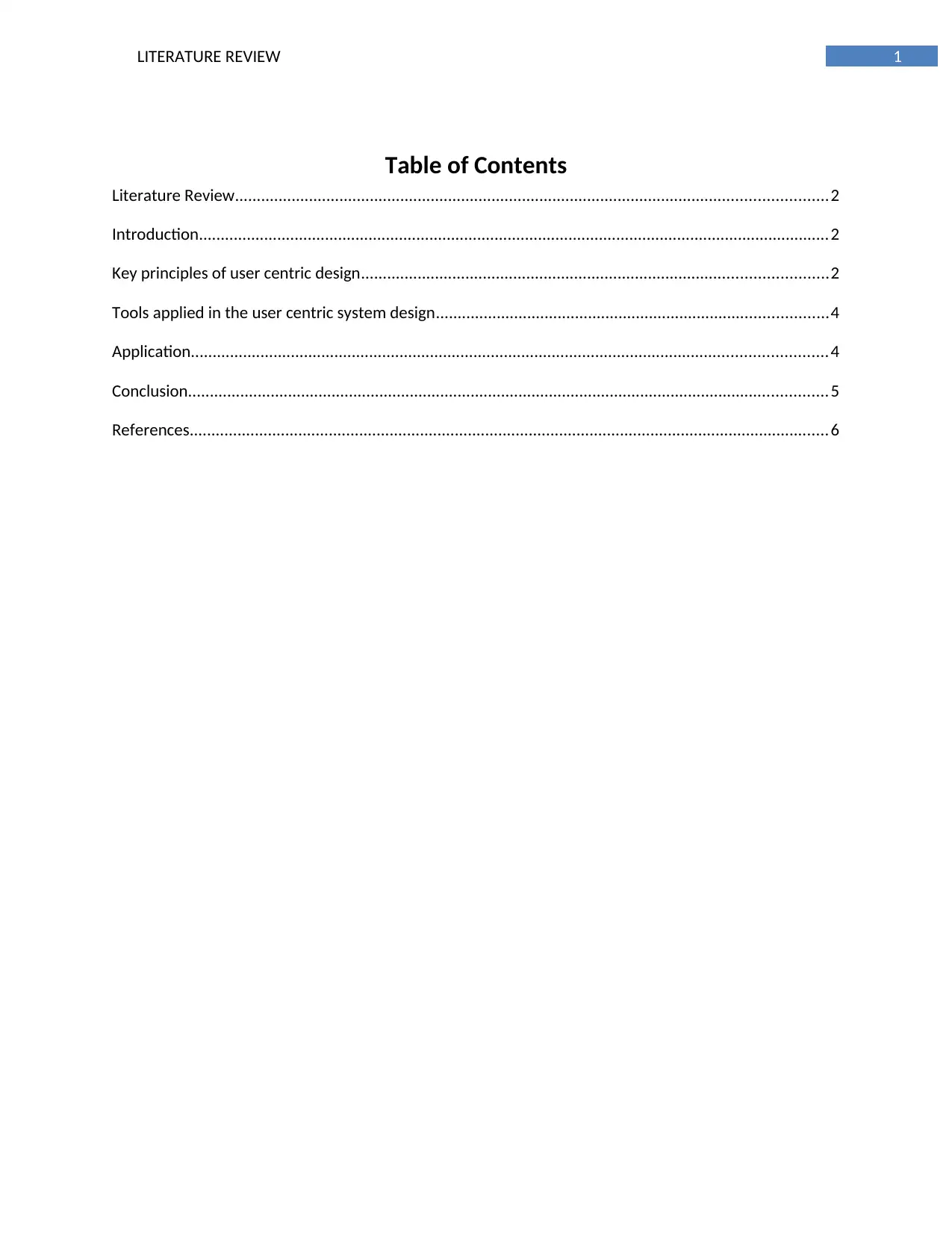
1LITERATURE REVIEW
Table of Contents
Literature Review........................................................................................................................................2
Introduction.................................................................................................................................................2
Key principles of user centric design...........................................................................................................2
Tools applied in the user centric system design..........................................................................................4
Application..................................................................................................................................................4
Conclusion...................................................................................................................................................5
References...................................................................................................................................................6
Table of Contents
Literature Review........................................................................................................................................2
Introduction.................................................................................................................................................2
Key principles of user centric design...........................................................................................................2
Tools applied in the user centric system design..........................................................................................4
Application..................................................................................................................................................4
Conclusion...................................................................................................................................................5
References...................................................................................................................................................6
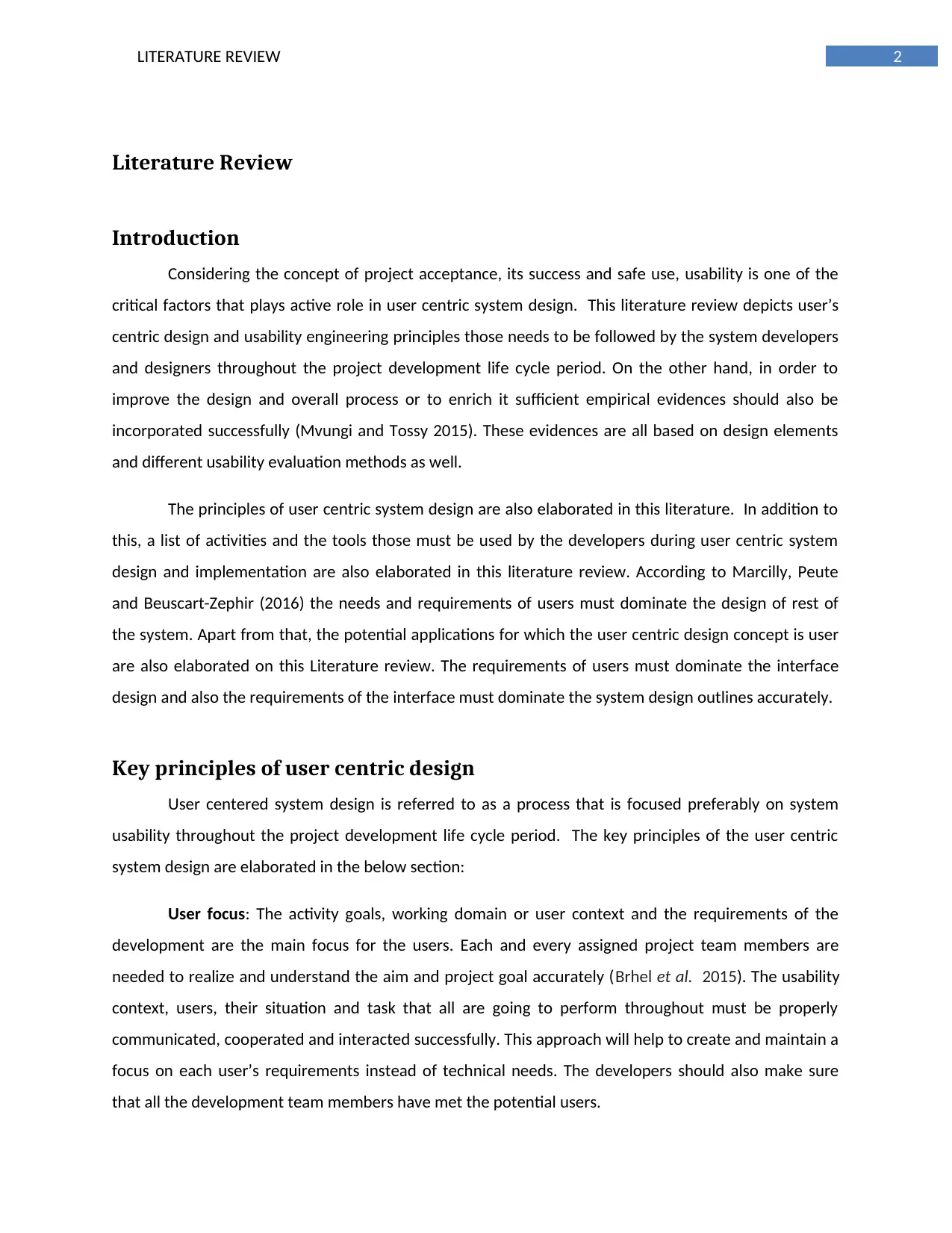
2LITERATURE REVIEW
Literature Review
Introduction
Considering the concept of project acceptance, its success and safe use, usability is one of the
critical factors that plays active role in user centric system design. This literature review depicts user’s
centric design and usability engineering principles those needs to be followed by the system developers
and designers throughout the project development life cycle period. On the other hand, in order to
improve the design and overall process or to enrich it sufficient empirical evidences should also be
incorporated successfully (Mvungi and Tossy 2015). These evidences are all based on design elements
and different usability evaluation methods as well.
The principles of user centric system design are also elaborated in this literature. In addition to
this, a list of activities and the tools those must be used by the developers during user centric system
design and implementation are also elaborated in this literature review. According to Marcilly, Peute
and Beuscart-Zephir (2016) the needs and requirements of users must dominate the design of rest of
the system. Apart from that, the potential applications for which the user centric design concept is user
are also elaborated on this Literature review. The requirements of users must dominate the interface
design and also the requirements of the interface must dominate the system design outlines accurately.
Key principles of user centric design
User centered system design is referred to as a process that is focused preferably on system
usability throughout the project development life cycle period. The key principles of the user centric
system design are elaborated in the below section:
User focus: The activity goals, working domain or user context and the requirements of the
development are the main focus for the users. Each and every assigned project team members are
needed to realize and understand the aim and project goal accurately (Brhel et al. 2015). The usability
context, users, their situation and task that all are going to perform throughout must be properly
communicated, cooperated and interacted successfully. This approach will help to create and maintain a
focus on each user’s requirements instead of technical needs. The developers should also make sure
that all the development team members have met the potential users.
Literature Review
Introduction
Considering the concept of project acceptance, its success and safe use, usability is one of the
critical factors that plays active role in user centric system design. This literature review depicts user’s
centric design and usability engineering principles those needs to be followed by the system developers
and designers throughout the project development life cycle period. On the other hand, in order to
improve the design and overall process or to enrich it sufficient empirical evidences should also be
incorporated successfully (Mvungi and Tossy 2015). These evidences are all based on design elements
and different usability evaluation methods as well.
The principles of user centric system design are also elaborated in this literature. In addition to
this, a list of activities and the tools those must be used by the developers during user centric system
design and implementation are also elaborated in this literature review. According to Marcilly, Peute
and Beuscart-Zephir (2016) the needs and requirements of users must dominate the design of rest of
the system. Apart from that, the potential applications for which the user centric design concept is user
are also elaborated on this Literature review. The requirements of users must dominate the interface
design and also the requirements of the interface must dominate the system design outlines accurately.
Key principles of user centric design
User centered system design is referred to as a process that is focused preferably on system
usability throughout the project development life cycle period. The key principles of the user centric
system design are elaborated in the below section:
User focus: The activity goals, working domain or user context and the requirements of the
development are the main focus for the users. Each and every assigned project team members are
needed to realize and understand the aim and project goal accurately (Brhel et al. 2015). The usability
context, users, their situation and task that all are going to perform throughout must be properly
communicated, cooperated and interacted successfully. This approach will help to create and maintain a
focus on each user’s requirements instead of technical needs. The developers should also make sure
that all the development team members have met the potential users.
⊘ This is a preview!⊘
Do you want full access?
Subscribe today to unlock all pages.

Trusted by 1+ million students worldwide
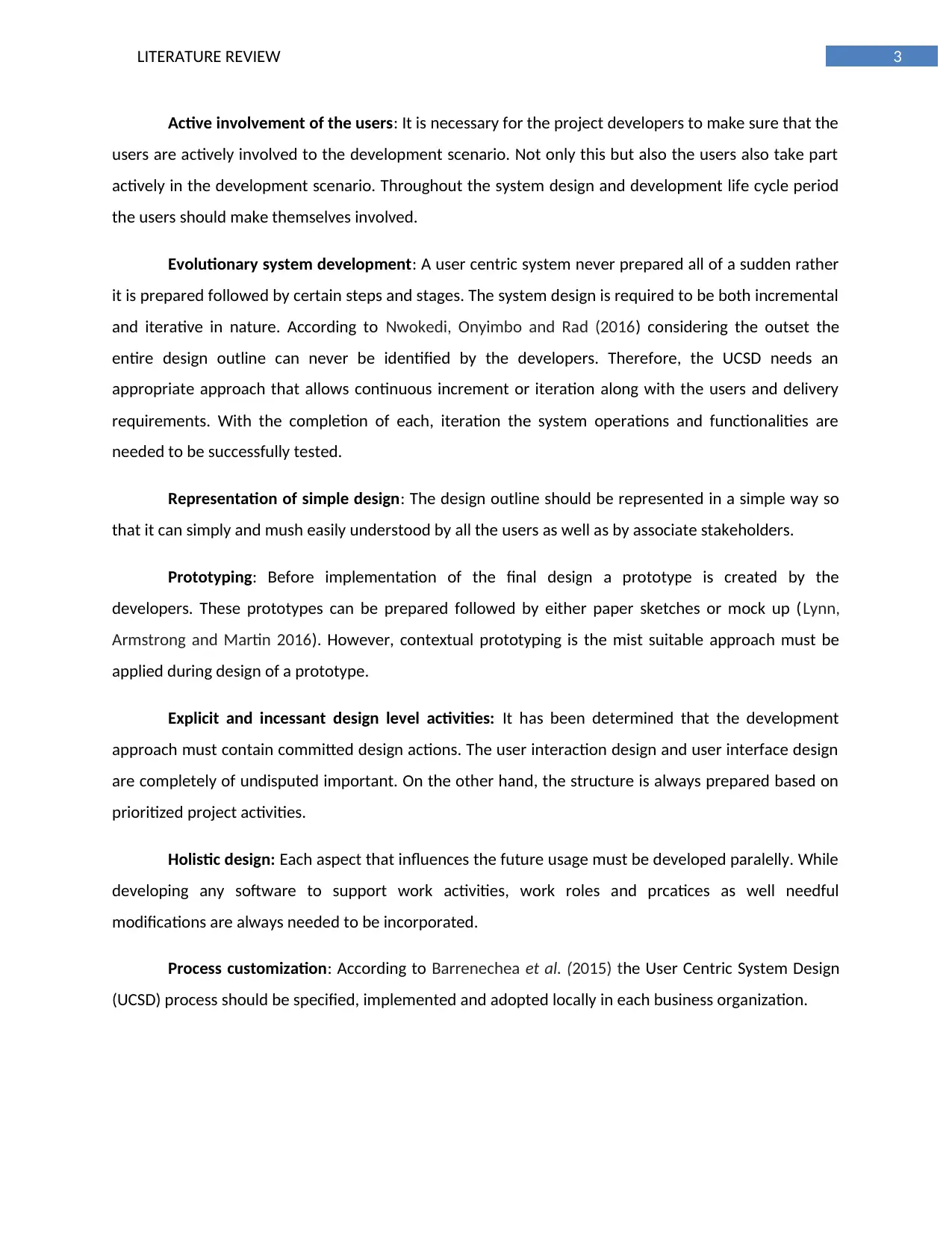
3LITERATURE REVIEW
Active involvement of the users: It is necessary for the project developers to make sure that the
users are actively involved to the development scenario. Not only this but also the users also take part
actively in the development scenario. Throughout the system design and development life cycle period
the users should make themselves involved.
Evolutionary system development: A user centric system never prepared all of a sudden rather
it is prepared followed by certain steps and stages. The system design is required to be both incremental
and iterative in nature. According to Nwokedi, Onyimbo and Rad (2016) considering the outset the
entire design outline can never be identified by the developers. Therefore, the UCSD needs an
appropriate approach that allows continuous increment or iteration along with the users and delivery
requirements. With the completion of each, iteration the system operations and functionalities are
needed to be successfully tested.
Representation of simple design: The design outline should be represented in a simple way so
that it can simply and mush easily understood by all the users as well as by associate stakeholders.
Prototyping: Before implementation of the final design a prototype is created by the
developers. These prototypes can be prepared followed by either paper sketches or mock up (Lynn,
Armstrong and Martin 2016). However, contextual prototyping is the mist suitable approach must be
applied during design of a prototype.
Explicit and incessant design level activities: It has been determined that the development
approach must contain committed design actions. The user interaction design and user interface design
are completely of undisputed important. On the other hand, the structure is always prepared based on
prioritized project activities.
Holistic design: Each aspect that influences the future usage must be developed paralelly. While
developing any software to support work activities, work roles and prcatices as well needful
modifications are always needed to be incorporated.
Process customization: According to Barrenechea et al. (2015) the User Centric System Design
(UCSD) process should be specified, implemented and adopted locally in each business organization.
Active involvement of the users: It is necessary for the project developers to make sure that the
users are actively involved to the development scenario. Not only this but also the users also take part
actively in the development scenario. Throughout the system design and development life cycle period
the users should make themselves involved.
Evolutionary system development: A user centric system never prepared all of a sudden rather
it is prepared followed by certain steps and stages. The system design is required to be both incremental
and iterative in nature. According to Nwokedi, Onyimbo and Rad (2016) considering the outset the
entire design outline can never be identified by the developers. Therefore, the UCSD needs an
appropriate approach that allows continuous increment or iteration along with the users and delivery
requirements. With the completion of each, iteration the system operations and functionalities are
needed to be successfully tested.
Representation of simple design: The design outline should be represented in a simple way so
that it can simply and mush easily understood by all the users as well as by associate stakeholders.
Prototyping: Before implementation of the final design a prototype is created by the
developers. These prototypes can be prepared followed by either paper sketches or mock up (Lynn,
Armstrong and Martin 2016). However, contextual prototyping is the mist suitable approach must be
applied during design of a prototype.
Explicit and incessant design level activities: It has been determined that the development
approach must contain committed design actions. The user interaction design and user interface design
are completely of undisputed important. On the other hand, the structure is always prepared based on
prioritized project activities.
Holistic design: Each aspect that influences the future usage must be developed paralelly. While
developing any software to support work activities, work roles and prcatices as well needful
modifications are always needed to be incorporated.
Process customization: According to Barrenechea et al. (2015) the User Centric System Design
(UCSD) process should be specified, implemented and adopted locally in each business organization.
Paraphrase This Document
Need a fresh take? Get an instant paraphrase of this document with our AI Paraphraser
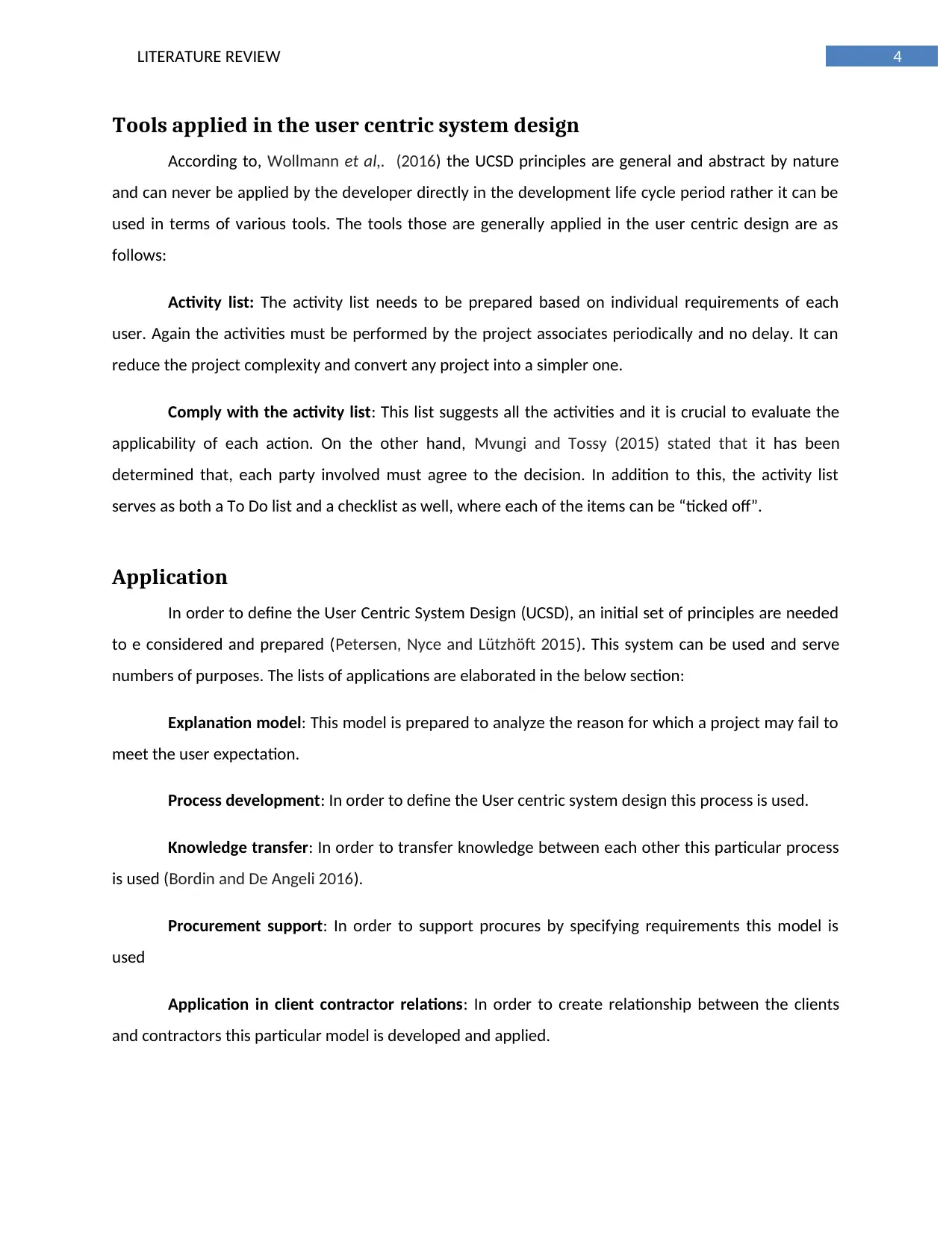
4LITERATURE REVIEW
Tools applied in the user centric system design
According to, Wollmann et al,. (2016) the UCSD principles are general and abstract by nature
and can never be applied by the developer directly in the development life cycle period rather it can be
used in terms of various tools. The tools those are generally applied in the user centric design are as
follows:
Activity list: The activity list needs to be prepared based on individual requirements of each
user. Again the activities must be performed by the project associates periodically and no delay. It can
reduce the project complexity and convert any project into a simpler one.
Comply with the activity list: This list suggests all the activities and it is crucial to evaluate the
applicability of each action. On the other hand, Mvungi and Tossy (2015) stated that it has been
determined that, each party involved must agree to the decision. In addition to this, the activity list
serves as both a To Do list and a checklist as well, where each of the items can be “ticked off”.
Application
In order to define the User Centric System Design (UCSD), an initial set of principles are needed
to e considered and prepared (Petersen, Nyce and Lützhöft 2015). This system can be used and serve
numbers of purposes. The lists of applications are elaborated in the below section:
Explanation model: This model is prepared to analyze the reason for which a project may fail to
meet the user expectation.
Process development: In order to define the User centric system design this process is used.
Knowledge transfer: In order to transfer knowledge between each other this particular process
is used (Bordin and De Angeli 2016).
Procurement support: In order to support procures by specifying requirements this model is
used
Application in client contractor relations: In order to create relationship between the clients
and contractors this particular model is developed and applied.
Tools applied in the user centric system design
According to, Wollmann et al,. (2016) the UCSD principles are general and abstract by nature
and can never be applied by the developer directly in the development life cycle period rather it can be
used in terms of various tools. The tools those are generally applied in the user centric design are as
follows:
Activity list: The activity list needs to be prepared based on individual requirements of each
user. Again the activities must be performed by the project associates periodically and no delay. It can
reduce the project complexity and convert any project into a simpler one.
Comply with the activity list: This list suggests all the activities and it is crucial to evaluate the
applicability of each action. On the other hand, Mvungi and Tossy (2015) stated that it has been
determined that, each party involved must agree to the decision. In addition to this, the activity list
serves as both a To Do list and a checklist as well, where each of the items can be “ticked off”.
Application
In order to define the User Centric System Design (UCSD), an initial set of principles are needed
to e considered and prepared (Petersen, Nyce and Lützhöft 2015). This system can be used and serve
numbers of purposes. The lists of applications are elaborated in the below section:
Explanation model: This model is prepared to analyze the reason for which a project may fail to
meet the user expectation.
Process development: In order to define the User centric system design this process is used.
Knowledge transfer: In order to transfer knowledge between each other this particular process
is used (Bordin and De Angeli 2016).
Procurement support: In order to support procures by specifying requirements this model is
used
Application in client contractor relations: In order to create relationship between the clients
and contractors this particular model is developed and applied.
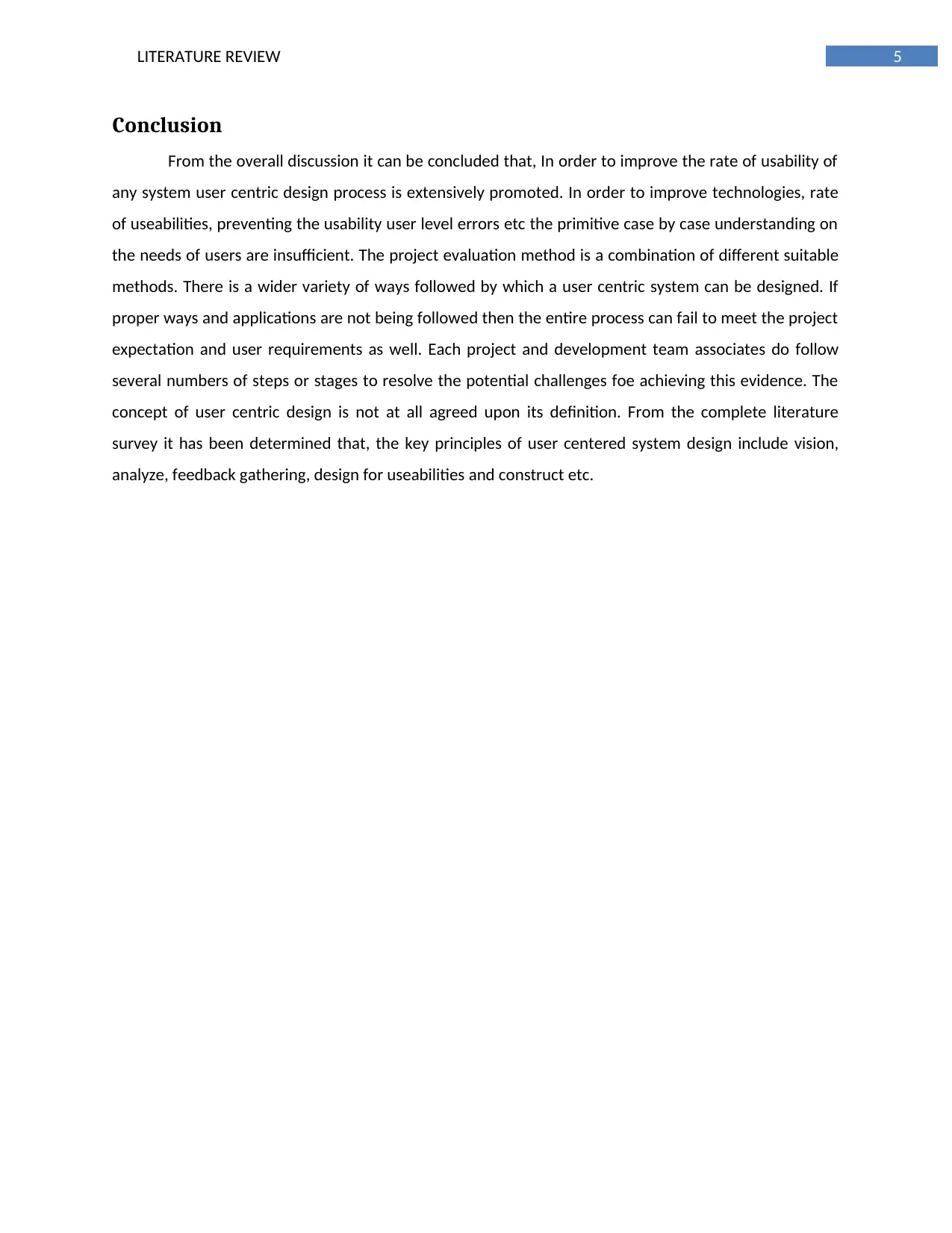
5LITERATURE REVIEW
Conclusion
From the overall discussion it can be concluded that, In order to improve the rate of usability of
any system user centric design process is extensively promoted. In order to improve technologies, rate
of useabilities, preventing the usability user level errors etc the primitive case by case understanding on
the needs of users are insufficient. The project evaluation method is a combination of different suitable
methods. There is a wider variety of ways followed by which a user centric system can be designed. If
proper ways and applications are not being followed then the entire process can fail to meet the project
expectation and user requirements as well. Each project and development team associates do follow
several numbers of steps or stages to resolve the potential challenges foe achieving this evidence. The
concept of user centric design is not at all agreed upon its definition. From the complete literature
survey it has been determined that, the key principles of user centered system design include vision,
analyze, feedback gathering, design for useabilities and construct etc.
Conclusion
From the overall discussion it can be concluded that, In order to improve the rate of usability of
any system user centric design process is extensively promoted. In order to improve technologies, rate
of useabilities, preventing the usability user level errors etc the primitive case by case understanding on
the needs of users are insufficient. The project evaluation method is a combination of different suitable
methods. There is a wider variety of ways followed by which a user centric system can be designed. If
proper ways and applications are not being followed then the entire process can fail to meet the project
expectation and user requirements as well. Each project and development team associates do follow
several numbers of steps or stages to resolve the potential challenges foe achieving this evidence. The
concept of user centric design is not at all agreed upon its definition. From the complete literature
survey it has been determined that, the key principles of user centered system design include vision,
analyze, feedback gathering, design for useabilities and construct etc.
⊘ This is a preview!⊘
Do you want full access?
Subscribe today to unlock all pages.

Trusted by 1+ million students worldwide
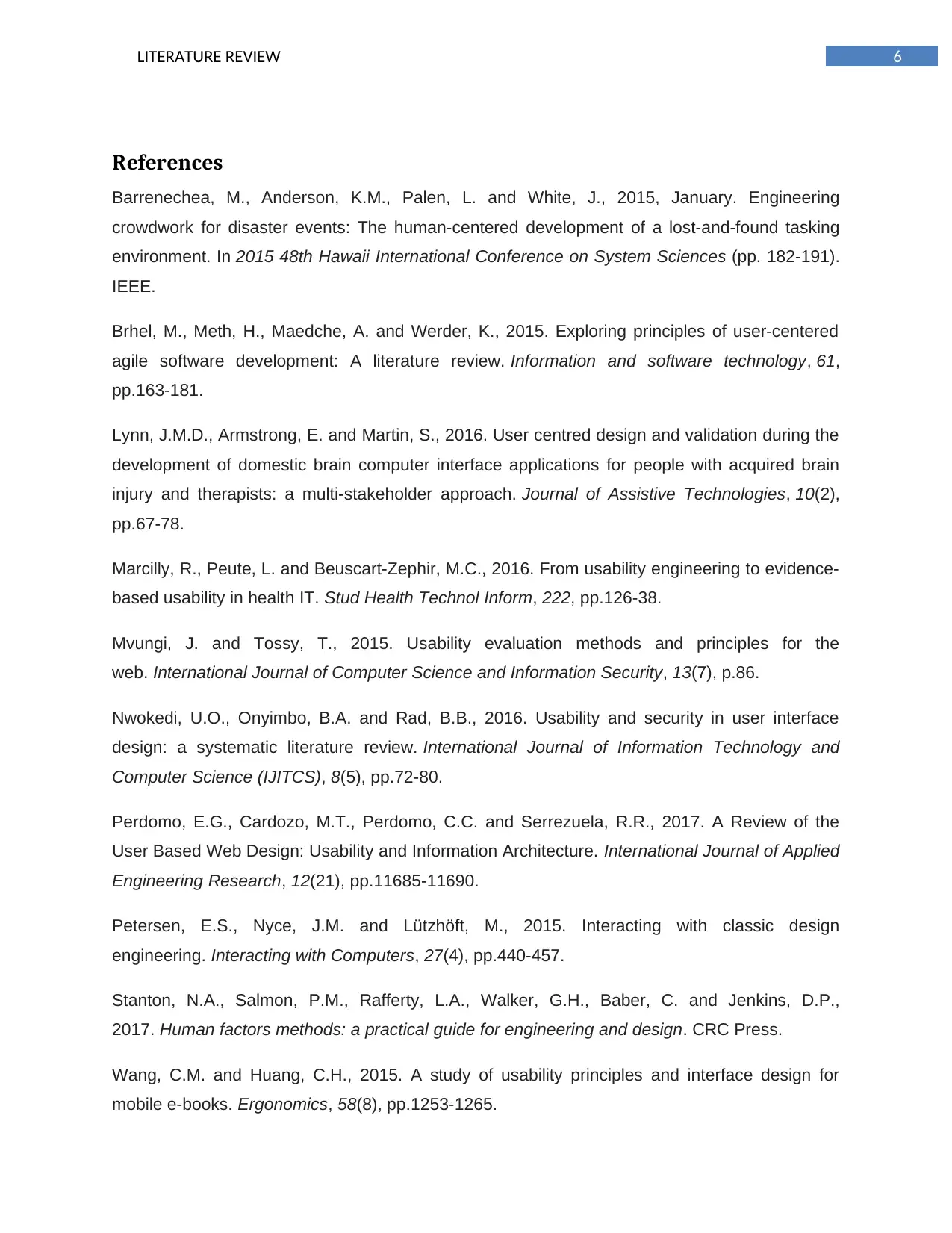
6LITERATURE REVIEW
References
Barrenechea, M., Anderson, K.M., Palen, L. and White, J., 2015, January. Engineering
crowdwork for disaster events: The human-centered development of a lost-and-found tasking
environment. In 2015 48th Hawaii International Conference on System Sciences (pp. 182-191).
IEEE.
Brhel, M., Meth, H., Maedche, A. and Werder, K., 2015. Exploring principles of user-centered
agile software development: A literature review. Information and software technology, 61,
pp.163-181.
Lynn, J.M.D., Armstrong, E. and Martin, S., 2016. User centred design and validation during the
development of domestic brain computer interface applications for people with acquired brain
injury and therapists: a multi-stakeholder approach. Journal of Assistive Technologies, 10(2),
pp.67-78.
Marcilly, R., Peute, L. and Beuscart-Zephir, M.C., 2016. From usability engineering to evidence-
based usability in health IT. Stud Health Technol Inform, 222, pp.126-38.
Mvungi, J. and Tossy, T., 2015. Usability evaluation methods and principles for the
web. International Journal of Computer Science and Information Security, 13(7), p.86.
Nwokedi, U.O., Onyimbo, B.A. and Rad, B.B., 2016. Usability and security in user interface
design: a systematic literature review. International Journal of Information Technology and
Computer Science (IJITCS), 8(5), pp.72-80.
Perdomo, E.G., Cardozo, M.T., Perdomo, C.C. and Serrezuela, R.R., 2017. A Review of the
User Based Web Design: Usability and Information Architecture. International Journal of Applied
Engineering Research, 12(21), pp.11685-11690.
Petersen, E.S., Nyce, J.M. and Lützhöft, M., 2015. Interacting with classic design
engineering. Interacting with Computers, 27(4), pp.440-457.
Stanton, N.A., Salmon, P.M., Rafferty, L.A., Walker, G.H., Baber, C. and Jenkins, D.P.,
2017. Human factors methods: a practical guide for engineering and design. CRC Press.
Wang, C.M. and Huang, C.H., 2015. A study of usability principles and interface design for
mobile e-books. Ergonomics, 58(8), pp.1253-1265.
References
Barrenechea, M., Anderson, K.M., Palen, L. and White, J., 2015, January. Engineering
crowdwork for disaster events: The human-centered development of a lost-and-found tasking
environment. In 2015 48th Hawaii International Conference on System Sciences (pp. 182-191).
IEEE.
Brhel, M., Meth, H., Maedche, A. and Werder, K., 2015. Exploring principles of user-centered
agile software development: A literature review. Information and software technology, 61,
pp.163-181.
Lynn, J.M.D., Armstrong, E. and Martin, S., 2016. User centred design and validation during the
development of domestic brain computer interface applications for people with acquired brain
injury and therapists: a multi-stakeholder approach. Journal of Assistive Technologies, 10(2),
pp.67-78.
Marcilly, R., Peute, L. and Beuscart-Zephir, M.C., 2016. From usability engineering to evidence-
based usability in health IT. Stud Health Technol Inform, 222, pp.126-38.
Mvungi, J. and Tossy, T., 2015. Usability evaluation methods and principles for the
web. International Journal of Computer Science and Information Security, 13(7), p.86.
Nwokedi, U.O., Onyimbo, B.A. and Rad, B.B., 2016. Usability and security in user interface
design: a systematic literature review. International Journal of Information Technology and
Computer Science (IJITCS), 8(5), pp.72-80.
Perdomo, E.G., Cardozo, M.T., Perdomo, C.C. and Serrezuela, R.R., 2017. A Review of the
User Based Web Design: Usability and Information Architecture. International Journal of Applied
Engineering Research, 12(21), pp.11685-11690.
Petersen, E.S., Nyce, J.M. and Lützhöft, M., 2015. Interacting with classic design
engineering. Interacting with Computers, 27(4), pp.440-457.
Stanton, N.A., Salmon, P.M., Rafferty, L.A., Walker, G.H., Baber, C. and Jenkins, D.P.,
2017. Human factors methods: a practical guide for engineering and design. CRC Press.
Wang, C.M. and Huang, C.H., 2015. A study of usability principles and interface design for
mobile e-books. Ergonomics, 58(8), pp.1253-1265.
Paraphrase This Document
Need a fresh take? Get an instant paraphrase of this document with our AI Paraphraser
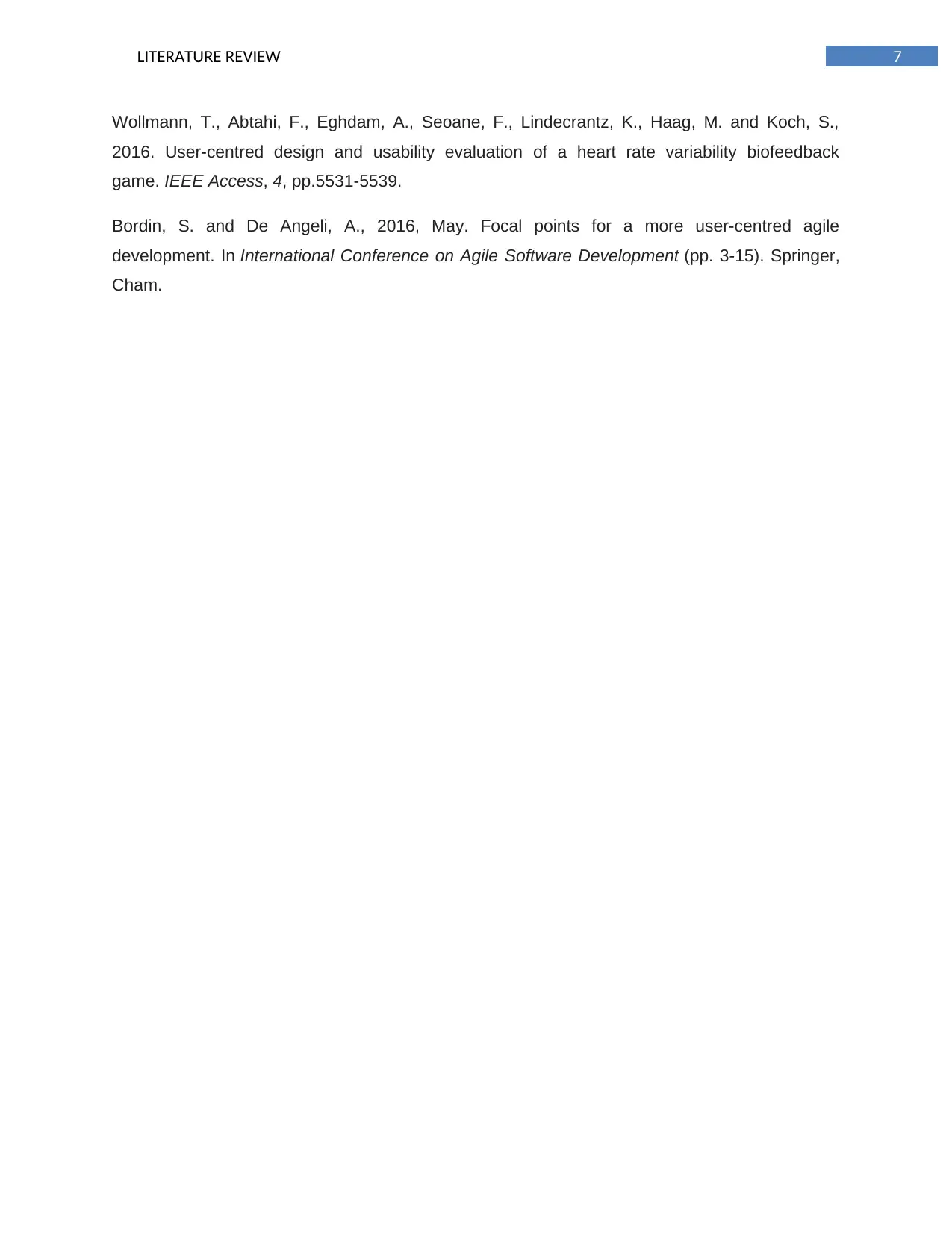
7LITERATURE REVIEW
Wollmann, T., Abtahi, F., Eghdam, A., Seoane, F., Lindecrantz, K., Haag, M. and Koch, S.,
2016. User-centred design and usability evaluation of a heart rate variability biofeedback
game. IEEE Access, 4, pp.5531-5539.
Bordin, S. and De Angeli, A., 2016, May. Focal points for a more user-centred agile
development. In International Conference on Agile Software Development (pp. 3-15). Springer,
Cham.
Wollmann, T., Abtahi, F., Eghdam, A., Seoane, F., Lindecrantz, K., Haag, M. and Koch, S.,
2016. User-centred design and usability evaluation of a heart rate variability biofeedback
game. IEEE Access, 4, pp.5531-5539.
Bordin, S. and De Angeli, A., 2016, May. Focal points for a more user-centred agile
development. In International Conference on Agile Software Development (pp. 3-15). Springer,
Cham.
1 out of 8
Related Documents
Your All-in-One AI-Powered Toolkit for Academic Success.
+13062052269
info@desklib.com
Available 24*7 on WhatsApp / Email
![[object Object]](/_next/static/media/star-bottom.7253800d.svg)
Unlock your academic potential
Copyright © 2020–2025 A2Z Services. All Rights Reserved. Developed and managed by ZUCOL.




